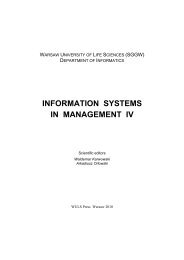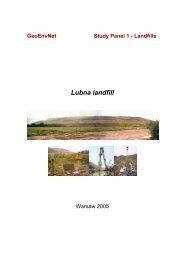ACTA SCIENTIARUM POLONORUM - SGGW
ACTA SCIENTIARUM POLONORUM - SGGW
ACTA SCIENTIARUM POLONORUM - SGGW
You also want an ePaper? Increase the reach of your titles
YUMPU automatically turns print PDFs into web optimized ePapers that Google loves.
Differences in possible reactions of eu farmers from selected european regions... 49RESULTSThere were 2363 farmers from 11 regions located in 9 countries of the European Unioninterviewed in the survey. Selected information on farms’ characteristics is presented inTable 2. The average size of a farm in the sample was almost 100 ha 2 , however averagesin different regions varied significantly. The smallest farms were observed in Macedoniaand Thrace (Greece) and only slightly larger are the farms in Podlaskie (Poland) andEmilia-Romagna (Italy). The largest average UAA was noted in North East of Scotlandand Ostprignitz-Ruppin/North-East Brandenburg (Germany). The surveyed group wasalso significantly differentiated from the farms’ specialization point of view. However, thedistribution of the three main types of production (crop, livestock and mixed farms) turnedout to be similar (about 1/3 of farms falls into each specialization). In most of the regionsthe interviewees categorized their farms slightly more frequently as specialized in cropsor mixed. The share of farms specialized in livestock was the highest in the samples fromPodlaskie (Poland) and Noord-Holland (Netherlands) regions. Noticeable differences betweenthe regions can be also found as regards the importance of revenues from farming incontributing to the total household ‘s income (Table 2). Households with dominating agriculturalincome were observed mainly in Macedonia and Thrace Region (Greece) (80%of farms with share of agricultural income more than 70%) as well as in Podlaskie, Noord-Holland (Netherlands) and North East of Scotland (UK) regions (which percent of farmswith share of agricultural income higher than 70% is respectively 65%, 60% and 59%).On the opposite in the Lahn-Dill-District (Germany) region more than 80% of interviewedfarmers declared a share of agricultural income on the level below 30%. On the averagein the survey only slightly above 50% of households achieved more than 70% of incomesfrom farming. Rather small share of households with non-farming activities (about 20% inwhole sample) suggests that the sources of non-agricultural income must be off farm jobsor different forms of social support. A noticeable difference in demographic characteristicsof farmers between regions has been observed in the survey. The mean age of farmers wasabout 49 years, but farmers in Emilia-Romagna (Italy) were, on average, 10 years olderwhilst in Podlaskie 10 years younger than the sample average. Interviewed farmers fromall regions are well educated. On average more than 65% of farmers reported a high (secondary)school education, but again education level varies significantly between regions.When taking into account the share of respondents participating in farmers’ organizationsa similar differentiation is observed. On average a half of interviewed farmers were membersof such organizations. The range of participation varied, however, from nearly 10% inthe Podlaskie region to almost 90% in Emilia-Romagna (Italy).Examining possible reactions of farmers to likely CAP reforms was the key issuein the survey. The most general question was about the future continuation of farmingactivities. The percentage of farmers declaring the continuation of farming until 2020 ispresented in Figure 1. On average, assuming the present shape of CAP in the Baselinescenario, about 75% of interviewees declared continuation, while under No CAP Scenariosuch declaration was made by 45% of the farmers. A negative answer (discontinu-2Total land = owned land + rent in – rent out.Oeconomia 10 (1) 2011
















